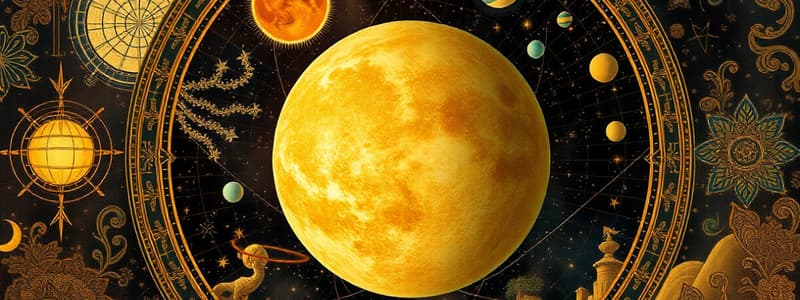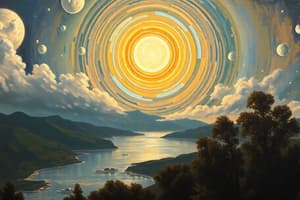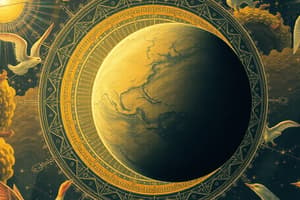Podcast
Questions and Answers
Which type of star is characterized as being very large in size and follows the main sequence phase?
Which type of star is characterized as being very large in size and follows the main sequence phase?
- Main Sequence Stars
- Red Giants (correct)
- Neutron Stars (correct)
- Dwarf Stars
What is the outcome of a high mass star after it undergoes a supernova?
What is the outcome of a high mass star after it undergoes a supernova?
- It forms a Red Giant
- It becomes a Black Hole (correct)
- It turns into a Dwarf Star
- It becomes a Main Sequence Star
Which theory is currently considered the best explanation for the origin of the solar system?
Which theory is currently considered the best explanation for the origin of the solar system?
- Nebular Hypothesis
- Solar Nebula Theory (correct)
- Steady State Theory
- Big Bang Theory
In which order does the life cycle of the universe begin?
In which order does the life cycle of the universe begin?
What causes redshift in the universe, indicating its expansion?
What causes redshift in the universe, indicating its expansion?
What process occurs in the core of a star to generate energy?
What process occurs in the core of a star to generate energy?
Which type of star is the Sun classified as?
Which type of star is the Sun classified as?
What is the definition of luminosity in astronomy?
What is the definition of luminosity in astronomy?
On the Hertzsprung-Russell Diagram, what relationship does it illustrate?
On the Hertzsprung-Russell Diagram, what relationship does it illustrate?
Which of the following describes an irregular galaxy?
Which of the following describes an irregular galaxy?
Which color represents the hottest stars in the universe?
Which color represents the hottest stars in the universe?
What is the distance that light travels in one year called?
What is the distance that light travels in one year called?
Which planets are classified as terrestrial planets?
Which planets are classified as terrestrial planets?
What is the primary factor that controls a star's life cycle and ultimate fate?
What is the primary factor that controls a star's life cycle and ultimate fate?
What characteristic is common among Jovian planets?
What characteristic is common among Jovian planets?
What is the primary reason Earth can support life?
What is the primary reason Earth can support life?
Which planet is known as 'Earth's Twin'?
Which planet is known as 'Earth's Twin'?
Which object in space is described as causing meteor showers?
Which object in space is described as causing meteor showers?
What is the largest volcano in the solar system?
What is the largest volcano in the solar system?
Which of the following best describes a meteorite?
Which of the following best describes a meteorite?
What defines the Asteroid Belt in the solar system?
What defines the Asteroid Belt in the solar system?
Flashcards
What are red giants?
What are red giants?
Stars in this category are very large and bright. They are also known for their reddish color.
What is a supernova?
What is a supernova?
A massive star collapses on itself, creating a massive explosion that releases immense energy.
What is the Big Bang Theory?
What is the Big Bang Theory?
The universe began as a dense, hot point that rapidly expanded. This expansion continues today, and we can observe it through the redshift of galaxies.
What is the Solar Nebula Theory?
What is the Solar Nebula Theory?
Signup and view all the flashcards
What is the star life cycle?
What is the star life cycle?
Signup and view all the flashcards
Inner Planets
Inner Planets
Signup and view all the flashcards
Outer Planets
Outer Planets
Signup and view all the flashcards
Asteroids
Asteroids
Signup and view all the flashcards
Comets
Comets
Signup and view all the flashcards
Meteor
Meteor
Signup and view all the flashcards
Moons
Moons
Signup and view all the flashcards
Meteorite
Meteorite
Signup and view all the flashcards
Meteor Shower
Meteor Shower
Signup and view all the flashcards
Corona
Corona
Signup and view all the flashcards
Chromosphere
Chromosphere
Signup and view all the flashcards
Photosphere
Photosphere
Signup and view all the flashcards
Nuclear Fusion
Nuclear Fusion
Signup and view all the flashcards
Light Year
Light Year
Signup and view all the flashcards
Parallax
Parallax
Signup and view all the flashcards
Apparent Magnitude
Apparent Magnitude
Signup and view all the flashcards
Hertzsprung-Russell Diagram
Hertzsprung-Russell Diagram
Signup and view all the flashcards
Study Notes
SOLAR SYSTEM
- Inner Planets: The first four planets closest to the Sun (Mercury, Venus, Earth, and Mars). They are solid rock and have few moons. Their orbits are short around the Sun. They are also called terrestrial planets.
- Outer Planets: The last four planets farthest from the Sun (Jupiter, Saturn, Uranus, and Neptune). They are made of hydrogen and helium, have ring systems, and many moons. Their orbits are long around the Sun. They are also called Jovian planets.
- Planet Trivia + Order:
- Mercury: Closest to the Sun, fastest orbital velocity.
- Venus: Second from the Sun, hottest planet, sometimes called "Earth's twin."
- Earth: Third from the Sun, has liquid water, life, rotation of 1 day, and revolution around the Sun of 1 year. Axis tilt is 23.5 degrees.
- Mars: Fourth from the Sun, Olympus Mons is the largest volcano in the solar system.
- Asteroid Belt: Separates the inner and outer planets, composed of small rocky bodies.
- Jupiter: Fifth from the Sun, largest planet, has the Great Red Spot.
- Saturn: Sixth from the Sun, largest ring system.
- Uranus: Seventh from the Sun, magnetic field is nearly upright.
- Neptune: Eighth from the Sun, has a Great Dark Spot (Hurricane).
- Pluto (Dwarf Planet): Not considered a planet anymore.
MINOR OBJECTS
- Moons: Natural satellites of planets, vary widely in composition.
- Meteoroids: Small rocky and metallic objects floating in space.
- Meteor: A flash of light seen in the sky (shooting star), caused by meteoroids burning up in the atmosphere.
- Meteorite: A meteoroid that survives its passage through the atmosphere and lands on Earth's surface.
- Meteor Shower: Caused by comets passing through Earth's orbit.
- Comets: Frozen ammonia, methane, water, rock, and dirt; comet tails always point away from the sun due to solar winds.
- Asteroids: Many orbit between Mars and Jupiter, small rocky objects.
SUN
- Layers (outside → in): Corona, Chromosphere, Photosphere, Conductive/Radiative Zones, Core (where nuclear fusion occurs).
- Nuclear Fusion: Hydrogen fuses into helium releasing light, heat, and energy.
- Average Compared to Other Stars: Medium-sized, medium-mass, with a medium temperature. It is a main sequence yellow star.
UNIVERSE
- Distance:
- Light Year: Distance light travels in one year; used to measure distances in astronomy.
- Parallax: Apparent displacement of an object due to a change in the observer's position.
- Star Brightness:
- Luminosity: Brightness of a star compared to the Sun.
- Apparent Magnitude (m): Brightness of a star as seen from Earth.
- Absolute Magnitude (M): Brightness of a star as seen from a standard distance (32 light years).
- Surface Temperatures: Hottest stars are blue, coolest are red.
- Hertzsprung-Russell Diagram: Diagram that shows the relationship between the absolute magnitude of stars and their temperatures.
Constellations
- Patterns of stars in the night sky (88 in total).
Galaxies
- Collections of billions of stars.
- There are three basic types: Elliptical, Spiral, and Irregular.
Life Cycle of Stars
- Stars have a life cycle, and their mass controls their evolution, lifetime and fate. They are formed from the condensation of interstellar gas.
- Stages include: Stellar Nebula (birthplace of new stars), Main Sequence (most stars are in this category), Red Giants, Supergiants, White Dwarfs.
- Stars that are smaller in mass end as white dwarfs, and those that are much bigger end in supernova if their mass is sufficient enough to collapse in on themselves eventually ending up as black holes after emitting a huge amount of energy.
Universe Trivia
- The universe is vast, old, and still expanding (red shift).
- Big Bang Theory: Current model for the universe's origin.
- Solar Nebula Theory: Current model for the solar system's origin. The solar system formed through the condensing of the solar nebula. There is an order of events from the origin of the universe to the formation of life on Earth.
Studying That Suits You
Use AI to generate personalized quizzes and flashcards to suit your learning preferences.



